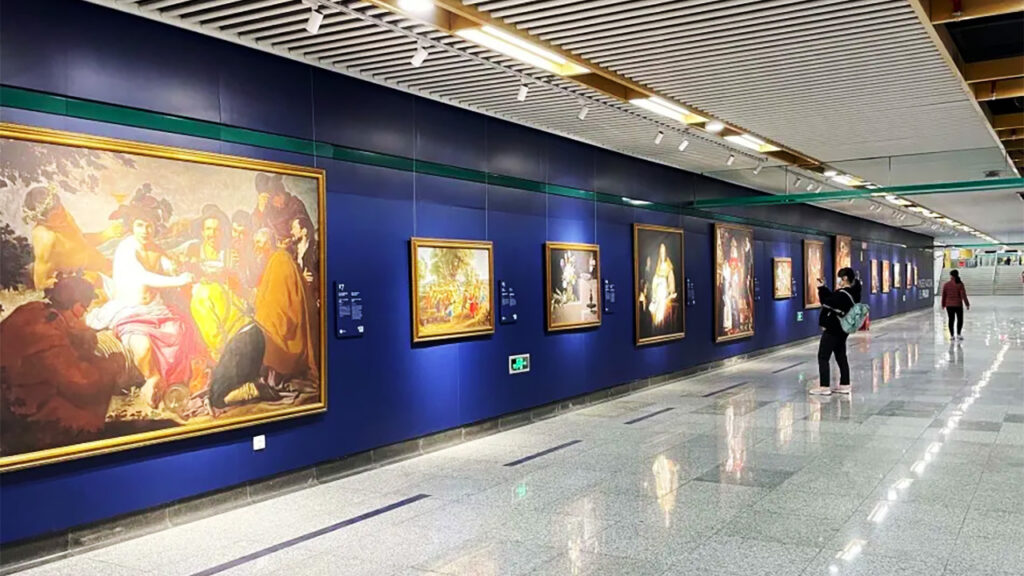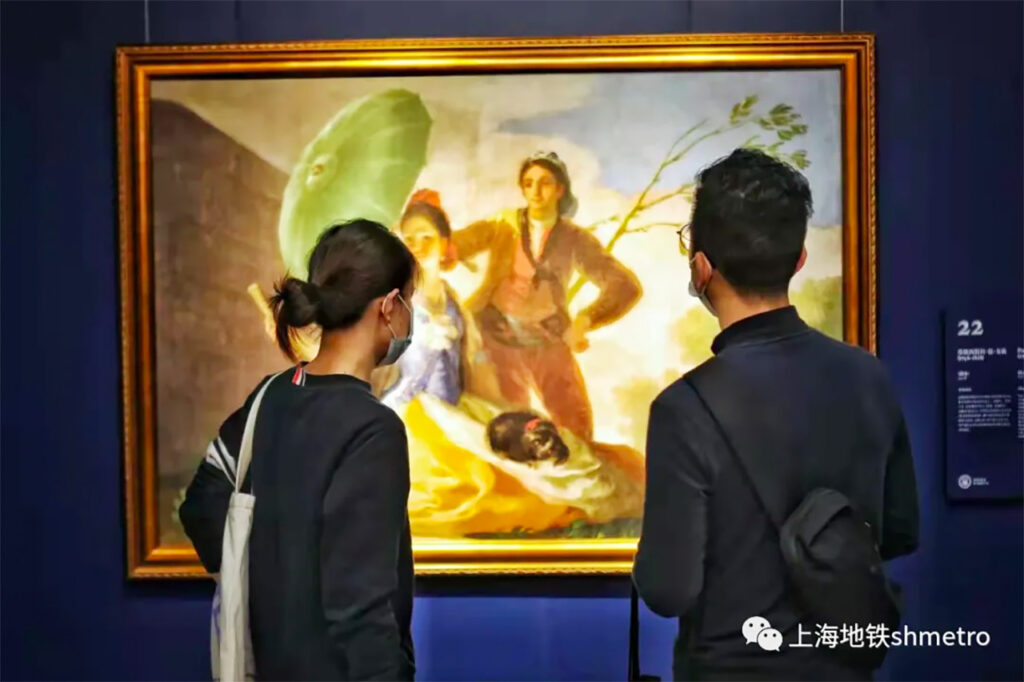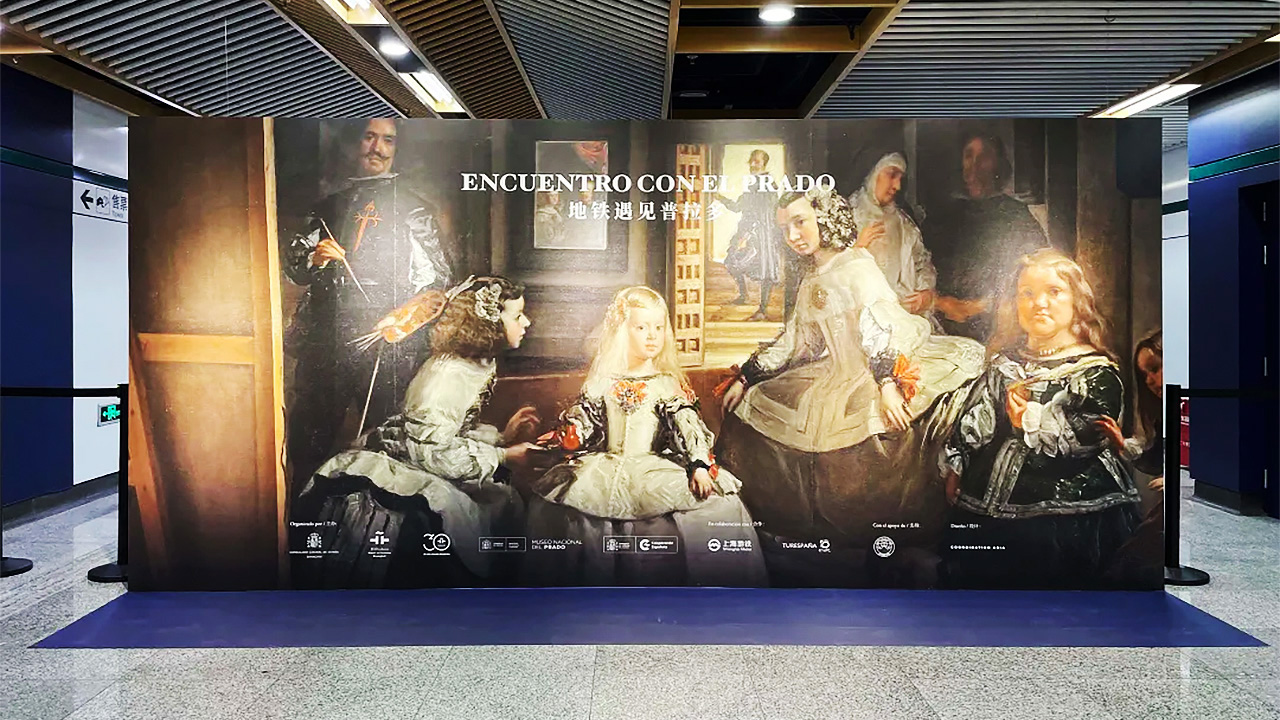Amid Madrid’s rolling lockdowns this year, the Prado Museum reached beyond its walls by stealthily deploying replica Titians and Velazquezs throughout its hometown. The initiative employed the spirit and execution of El Prado En Las Calles, a program that, for the past decade, has delivered the Prado’s collection to streets and squares of Lima, Manila, Albuquerque, and Mexico City. Now, it’s gone underground with a pop-up inside a Shanghai Metro Station.
Through February 2022, the 100,000-plus people who pass through Longhua Metro Station each day will encounter 29 of the museum’s best-known works, each reproduced in real size. Encounter The Prado strives to keep Spain and its grandest museum top of mind after a prolonged period of extremely limited outbound Chinese travel, one realized through a partnership between the Spanish Embassy in China, the Instituto Cervantes, and Turespaña.

Until next February, Longhua Metro Station will host Encounter The Prado, featuring real-sized recreations of the Prado’s most recognizable works. Image: 徐汇滨江周到 on WeChat
The pop-up exhibition, which includes replicas of Durer, El Greco, Rubens, Rembrandt, and Goya, is arranged chronologically, giving visitors an overview of European art history from the Renaissance through the 1800s. Accompanying videos reveal the stories behind the works as well as the museum’s efforts in conservation and restoration. By scanning a QR code located beside each image, visitors access the museum’s custom-built WeChat Mini Program, where users can “collect” works they like, go deeper by listening to audio explainers, and watch videos, such as an introduction to the museum by artist Cai Guo-Qiang or a piano recital from pianist Lang Lang.
Encounter The Prado is the museum’s first such foray into China. It follows European counterparts including the British Museum, the V&A, and the National Gallery, which have hosted pop-ups in major Chinese cities. Typically, these exhibitions serve to complement a broader range of tools to engage — and draw revenue from — Chinese audiences including livestreaming, social media activity, and e-commerce presence.

The Encounter The Prado WeChat Mini Program features videos (middle), including one of Cai Guo-Qiang visiting the Prado, and audio commentaries (right) that accompany each artwork. Image: Encounter The Prado WeChat Mini Program
The Prado seems poised to follow suit. “China is a country we’re interested in building strong relations [with],” Francisco Tardio, Senior Advisor for International Relations, tells Jing Culture & Commerce. “We want Chinese people to know the Prado and the incredible collection.” Below, Tardio elaborates on the museum’s China debut.
What was the impetus behind the exhibition?
This exhibition has its origins in 2011 with the first exhibition of El Prado En Las Calles. It’s a similar concept of people encountering Prado masterpieces on the streets. The exhibition has traveled through Latin America, Spain, the US, and Europe. In Shanghai, the project evolved to adapt to an indoor environment; we used the framework provided by the Instituto Cervantes which has a long-standing agreement for projects in Shanghai metro facilities.
The project involved numerous partners. Could you shed some light on how the project became a reality?
It was a big team effort. On the Spanish side, the Prado Museum, AECID, the Spanish Agency for Cooperation, the Miguel de Cervantes Library, the Spanish Tourism Office connected to the Embassy of Spain in Beijing, and the Ambassador himself had big involvement in the project. On the local side, the Shanghai People’s Association for the Friendship with Foreign Countries of Shanghai and the Shentong Metro corporation have been key partners, and of course the Shanghai Municipal Administration of Culture and Tourism.

“Chinese audiences are already important at the museum,” says Tardio, “but we think there is space to grow.” Image: 上海地铁 on WeChat
What about the curatorial decisions?
The Education Department at the Prado Museum is responsible for the curation of the exhibit and all of the technical elements. But again, we worked very closely with local authorities and the Spanish institutions in China to make sure the best and most appropriate choices were made for Shanghai. The video and digital features are materials produced in the museum and chosen for this exhibit, translated and subtitled by the Instituto Cervantes.
What has the response been to Prado’s digital activations?
This is another good example of teamwork. We’re working with the Cervantes Library and Turespaña in Beijing to communicate the exhibition through their WeChat accounts and we’ve already seen success. For example, on November 16 [International Flamenco Day], we launched a video of Flamenco dancers in the Prado and in hours, we had hundreds of thousands of views in Chinese social media.
Longer-term, what are the commercial and educational ambitions of the Prado in China?
The exhibition at the Metro is the first step. Hopefully, we will soon organize an exhibition in Chinese museums with the original paintings. Chinese audiences are already important at the museum, but we think there is space to grow. We plan to increase the intensity of our activities there to achieve our goals.



